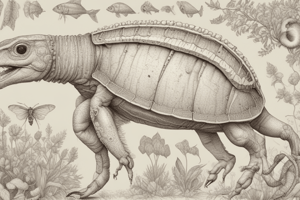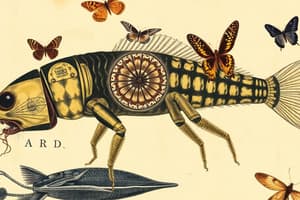Podcast
Questions and Answers
What allowed mollusks to scrape food from surfaces or drill into prey?
What allowed mollusks to scrape food from surfaces or drill into prey?
- Siphon
- Radula (correct)
- Tentacle
- Mantle
Which characteristic provided arthropods with adaptability and mobility?
Which characteristic provided arthropods with adaptability and mobility?
- Spiny skin
- Soft bodied structure
- Jointed appendages (correct)
- Radula
What structure enables echinoderms to move, feed, and respire?
What structure enables echinoderms to move, feed, and respire?
- Radula
- Calcified endoskeleton
- Water vascular system (correct)
- Chitinous exoskeleton
What significant advantage did the chitinous exoskeleton provide for arthropods?
What significant advantage did the chitinous exoskeleton provide for arthropods?
Which group was the first to develop an endoskeleton among marine invertebrates?
Which group was the first to develop an endoskeleton among marine invertebrates?
What type of circulatory system do annelids possess?
What type of circulatory system do annelids possess?
Which of the following is a unique feature of cephalopods?
Which of the following is a unique feature of cephalopods?
Which body structure is characteristic of arthropods?
Which body structure is characteristic of arthropods?
Where do echinoderms exclusively inhabit?
Where do echinoderms exclusively inhabit?
What type of reproduction is most common among mollusks?
What type of reproduction is most common among mollusks?
What is a defining characteristic of poriferans?
What is a defining characteristic of poriferans?
What functions do the tube feet of echinoderms serve?
What functions do the tube feet of echinoderms serve?
Which group of animals is the largest phylum?
Which group of animals is the largest phylum?
Which group of animals was the first to develop a specialized system to filter food particles from water?
Which group of animals was the first to develop a specialized system to filter food particles from water?
What was the first notable feature of Cnidaria that contributed to their predation abilities?
What was the first notable feature of Cnidaria that contributed to their predation abilities?
Which characteristic did Platyhelminthes first exhibit regarding body symmetry?
Which characteristic did Platyhelminthes first exhibit regarding body symmetry?
What major advancement in body structure was first seen in Nematodes?
What major advancement in body structure was first seen in Nematodes?
Which group was the first to have a closed circulatory system?
Which group was the first to have a closed circulatory system?
Mollusca were the first group to evolve what distinctive feature for protection?
Mollusca were the first group to evolve what distinctive feature for protection?
What does the term 'cephalization' refer to in relation to Platyhelminthes?
What does the term 'cephalization' refer to in relation to Platyhelminthes?
Which animal group was the first to show true tissues, such as muscle and nerve cells?
Which animal group was the first to show true tissues, such as muscle and nerve cells?
What unique ability do Porifera possess that distinguishes them from other animal phyla?
What unique ability do Porifera possess that distinguishes them from other animal phyla?
Which characteristic is not associated with Cnidaria?
Which characteristic is not associated with Cnidaria?
What is the defining body structure of Nematodes?
What is the defining body structure of Nematodes?
Which of the following statements about Platyhelminthes is true?
Which of the following statements about Platyhelminthes is true?
How do Annelida primarily move?
How do Annelida primarily move?
What distinguishes the feeding habit of Cnidaria from that of Porifera?
What distinguishes the feeding habit of Cnidaria from that of Porifera?
What type of reproduction is most common in Nematodes?
What type of reproduction is most common in Nematodes?
Which feature is unique to Cnidaria compared to other discussed phyla?
Which feature is unique to Cnidaria compared to other discussed phyla?
Flashcards
What are Porifera?
What are Porifera?
These simple animals are the most basic multicellular organisms, lacking true tissues, organs, and body symmetry. They filter food from water using specialized cells called choanocytes.
What are Cnidaria?
What are Cnidaria?
This phylum includes jellyfish, coral, sea anemones, and hydra. They are characterized by radial symmetry, two tissue layers, and specialized stinging cells called cnidocytes.
What are Platyhelminthes?
What are Platyhelminthes?
Flatworms are bilaterally symmetrical, have three tissue layers, and lack a body cavity. They include free-living forms and parasitic types like tapeworms and flukes.
What are Nematodes?
What are Nematodes?
Signup and view all the flashcards
What are Annelida?
What are Annelida?
Signup and view all the flashcards
How do Porifera feed?
How do Porifera feed?
Signup and view all the flashcards
How do Cnidaria feed?
How do Cnidaria feed?
Signup and view all the flashcards
How do Platyhelminthes exchange gases and transport nutrients?
How do Platyhelminthes exchange gases and transport nutrients?
Signup and view all the flashcards
Annelida
Annelida
Signup and view all the flashcards
Mollusca
Mollusca
Signup and view all the flashcards
Arthropoda
Arthropoda
Signup and view all the flashcards
Echinodermata
Echinodermata
Signup and view all the flashcards
Porifera
Porifera
Signup and view all the flashcards
Metamorphosis (in Arthropods)
Metamorphosis (in Arthropods)
Signup and view all the flashcards
Hydrostatic Skeleton
Hydrostatic Skeleton
Signup and view all the flashcards
External Fertilization
External Fertilization
Signup and view all the flashcards
What were cnidarians the first at?
What were cnidarians the first at?
Signup and view all the flashcards
What unique feature did cnidarians evolve?
What unique feature did cnidarians evolve?
Signup and view all the flashcards
What type of symmetry did platyhelminthes evolve?
What type of symmetry did platyhelminthes evolve?
Signup and view all the flashcards
What did platyhelminthes develop for information processing?
What did platyhelminthes develop for information processing?
Signup and view all the flashcards
What digestive system did nematodes develop?
What digestive system did nematodes develop?
Signup and view all the flashcards
What body cavity did nematodes evolve?
What body cavity did nematodes evolve?
Signup and view all the flashcards
What body plan did annelids develop?
What body plan did annelids develop?
Signup and view all the flashcards
What circulatory system did annelids evolve?
What circulatory system did annelids evolve?
Signup and view all the flashcards
What is a radula?
What is a radula?
Signup and view all the flashcards
What is a pseudocoelom?
What is a pseudocoelom?
Signup and view all the flashcards
What is a water vascular system?
What is a water vascular system?
Signup and view all the flashcards
What is an exoskeleton?
What is an exoskeleton?
Signup and view all the flashcards
What makes cephalopods unique?
What makes cephalopods unique?
Signup and view all the flashcards
Study Notes
Porifera (Sponges)
- Simplest multicellular animals
- Lack true tissues, organs, and symmetry
- Composed of porous bodies with canals for water flow
- Specialized cells (choanocytes) filter food
- Mostly marine, some freshwater species exist
- Filter feeders, obtaining nutrients by straining plankton and organic particles
- Reproduce asexually (budding or fragmentation) and sexually (produce gametes)
- Unique feature: Ability to regenerate lost parts
Cnidaria (Jellyfish, Corals, Sea Anemones, Hydra)
- Radially symmetrical, diploblastic (two tissue layers)
- Specialized stinging cells (cnidocytes)
- Two main body forms: polyp (sessile) and medusa (free-swimming)
- Simple nerve net, no centralized brain
- Carnivorous; use cnidocytes to capture prey
- Alternates between sexual and asexual reproduction in some species
- Unique feature: Corals form reefs, providing essential marine habitats
Platyhelminthes (Flatworms)
- Bilaterally symmetrical, triploblastic (three tissue layers)
- Acoelomate (no body cavity)
- Flattened dorsoventrally
- Simple organ systems
- Aquatic, terrestrial (moist environments), and parasitic (e.g., tapeworms, flukes)
- Simple brain (ganglia) and nerve cords
- Sexual (hermaphrodites) or asexual (regeneration)
- Unique feature: No circulatory or respiratory systems; diffusion used for gas exchange and nutrient transport
Nematodes (Roundworms)
- Bilaterally symmetrical, unsegmented, pseudocoelomate (body cavity not fully lined by mesoderm)
- Cylindrical body, covered by a tough cuticle
- Found in soil, water, and as parasites
- Diverse feeding strategies (free-living species are decomposers or parasites harm hosts)
- Sexual reproduction; sexes are usually separate
- Complete digestive tract with a mouth and anus
Annelida (Segmented Worms)
- Bilaterally symmetrical, coelomate (true body cavity)
- Segmented body.
- Segments separated by septa, possess setae (bristles) for movement
- Aquatic (marine and freshwater) and terrestrial (e.g., earthworms, leeches)
- Closed circulatory system with blood vessels
- Pair of cerebral ganglia and ventral nerve cord
- Hermaphroditic or separate sexes
- Unique feature: Well-developed hydrostatic skeleton for movement
Mollusca (Snails, Clams, Squids, Octopuses)
- Bilaterally symmetrical, coelomate, soft-bodied
- Often with a hard shell
- Body divided into head-foot, visceral mass, and mantle
- Marine, freshwater, and terrestrial environments
- Filter feeders (bivalves), grazers (gastropods), or predators (cephalopods)
- Nervous system varies in complexity; from simple to highly complex
- Mostly sexual; separate sexes or hermaphroditic
- Unique feature: Cephalopods exhibit high intelligence and advanced sensory organs
Arthropoda (Insects, Crustaceans, Spiders)
- Bilaterally symmetrical, segmented body
- Exoskeleton made of chitin
- Body divided into head, thorax, and abdomen; jointed appendages
- Great mobility and adaptability
- Chitinous exoskeleton provides protection and support, enabling colonization of diverse habitats
Echinodermata (Sea Stars, Sea Urchins, Sea Cucumbers)
- Radial symmetry in adults, bilateral in larvae; exclusively marine
- Endoskeleton made of calcium carbonate plates
- Water vascular system for movement and feeding
- Marine environments, from shallow to deep oceans, diverse feeding strategies
- Lack a centralized brain; have a nerve ring around the mouth
Studying That Suits You
Use AI to generate personalized quizzes and flashcards to suit your learning preferences.




